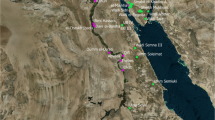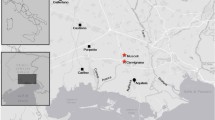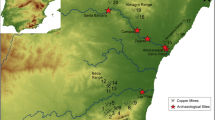Abstract
We present the results of a complex archaeometric study of Late Bronze Age copper ingots from the Staré Hodějovice hoard (South Bohemia). In order to understand the origin of the copper and describe the metallurgical process, we use modern analytical methods (metallography analyses, major/trace element and lead isotope analyses) to describe the samples. Within this study, a representative dataset of trace element composition and lead isotope ratios of non-alloyed and non-recycled corpus of copper ingots from the Late Bronze Age was created. We assume that most of the ingots were not altered by alloying, mixing or recycling. Based on lead isotope ratios and major/trace element composition, we suppose that the origin of the copper could be mostly Alpine ores from the Trentino and Mitterberg regions and possibly the Valais region. By this study, it was proved that copper smelted by a matte smelting process was transported in the form of flat or plano-convex ingots from multiple sources to South Bohemia, where it was subsequently refined and alloyed. Obtained analytical results refute the idea of prevailing copper recycling in the Late Bronze Age.









Similar content being viewed by others
References
Addis A (2013) Late Bronze Age metallurgy in the Italian Eastern Alps: copper smelting slags and mine exploitation. Dissertation, University of Padova
Addis A, Angelini I, Nimis P, Artioli G (2015) Late Bronze Age copper smelting slags from Luserna (Trentino, Italy): interpretation of the metallurgical process. Archaeometry 58:96–114. https://doi.org/10.1111/arcm.12160
Addis A, Angelini I, Artioli G (2017) Late Bronze Age copper smelting in the southeastern Alps: how standardized was the smelting process? Evidence from Transacqua and Segonzano, Trentino, Italy. Archaeol Anthropol Sci 9:985–999. https://doi.org/10.1007/s12520-016-0462-5
Artioli G, Baumgarten B, Marelli M, Giussani B, Recchia S, Nimis P, Giunti I, Angelini I, Omenetto P (2008) Chemical and isotopic tracers in Alpine copper deposits: geochemical links between mines and metal. Geo Alp 5:139–148
Artioli G, Angelini I, Nimis P, Villa IM (2016) A lead-isotope database of copper ores from the Southeastern Alps: a tool for the investigation of prehistoric copper metallurgy. J Archaeol Sci 75:27–39. https://doi.org/10.1016/j.jas.2016.09.005
Augustýnová M (2017) Metalurgické (Pod)krušnohoří – stopy po výrobě bronzu v době bronzové. Acta Rerum Naturalium 21:79–100
Bartelheim M (2007) Die Rolle der Metallurgie in vorgeschichtlichen Gesellschaften. Sozioökonomische und kulturhistorische Aspekte der Ressourcennutzung. Ein Vergleich zwische Andalusien, Zypern und dem Nordalpenraum, Verlag Marie Leidorf
Bartelheim M (2009) Elites and metals in the central European Early Bronze Age. In: Kienlin TL, Roberts BW (eds) Metals and societies, studies in honour of Barbara S. Ottaway. Universitätsforschungen zur prähistorischen Archäologie 169, Bonn, pp 34–46
Bartelheim M (2016) Metals as resources in the Early Bronze Age of Bohemia and Moravia. In: Bartelheim M, Horejs B, Krauß R (eds) Von Baden bis Troia – Ressourcennutzen. Metallurgie und Wissenstransfer, Rahden/Westf, pp 139–152
Bartelheim M, Niederschlag E (1998) Untersuchungen zur Buntmetallurgie, insbesondere des Kupfers und Zinns, im sächsisch-böhmische Erzgebirge und dessen Umland. Arbeits- und Forschungsberichte zur sächsischen Bodendenkmalpflege 40:8–87
Begemann F, Schmitt-Strecker S, Pernicka E, Lo Schiavo F (2001) Chemical composition and lead isotope of copper and bronze from Nuragic Sardinia. Eur J Archaeol 4:43–85. https://doi.org/10.1179/eja.2001.4.1.43
Blažek J, Ernée M, Smejtek L (1998) Die bronzezeitlichen Gußformen in Nordwestböhmen. Beiträge zur Ur- und Frühgeschichte Nordwestböhmens 3, Most
Bouzek J (2005) Böhmen und Bayern in der Urnenfelderzeit I. Germania 83:215–256
Breitenlechner E, Stöllner T, Thomas P, Lutz J, Oeggl K (2014) Prehistoric mining activities at the Mitterberg Main Lode (Salzburg, Austria). Archaeometry 56:102–128. https://doi.org/10.1111/arcm.12010
Budd P, Pollard A, Scaife B, Thomas R (2007) The possible fractionation of lead isotopes in ancient metallurgical processes. Archaeometry 37:143–150. https://doi.org/10.1111/j.1475-4754.1995.tb00732.x
Cattin F, Guénette-Beck B, Curdy P, Meisser N, Ansermet S, Hofmann B, Kündig R, Hubert V, Wörle M, Hametner K, Günther D, Wichser A, Ulrich A, Villa IM, Besse M (2011) Provenance of Early Bronze Age metal artefacts in Western Switzerland using elemental and lead isotopic compositions and their possible relation with copper minerals of the nearby Valais. J Archaeol Sci 38:1221–1233. https://doi.org/10.1016/j.jas.2010.12.016
Chmelíková D (2014) Ložiska měděné rudy u Mutěnína v západních Čechách a otázka jejich využití v pravěku. Acta Rerum Naturalium 16(2014):19–32
Chvojka O (2004) Jihovýchodní vlivy v jižních Čechách ve střední a mladší době bronzové. In: Kazdová E, Měřínský Z, Šabatová K (eds) K poctě Vladimíru Podborskému. Masarykova univerzita, Brno, pp 327–340
Chvojka O (2009) Jižní Čechy v mladší a pozdní době bronzové. Dissertationes Archaeologicae Brunenses/ Pragensesque 6, Brno
Chvojka O (2015) Bronzezeitliche Metallhortfunde in Südböhmen. Aktueller Forschungsstand, Fines Transire 24:49–65
Chvojka O, Hrubý P (2007) Höhenfundstellen der Bronze- und Hallstattzeit in Südböhmen und ihre Anknüpfung zum interregionalen Handelsaustausch. In: Baron J, Lasak I (eds.) Long distance trade in the Bronze Age and Early Iron Age. Studia Archeologiczne 40, pp. 71–88
Chvojka O, Hlásek D, Menšík P (2017a) Mitteleuropäische Kontakte der südböhmischen Bronzezeit. Fines Transire 26:133–145
Chvojka O, Jiráň L, Metlička M (eds.) (2017b) Nové české depoty doby bronzové. Hromadné nálezy kovových předmětů učiněné do roku 2013. České Budějovice – Praha – Plzeň
Chytráček M (1992) Doklady metalurgie v pozdní době bronzové na Černém vrchu u Svržna (okr. Domažlice) a otázka možného využívání zdrojů nerostných surovin. Sborník Západočeského musea v Plzni – Historie 8:59–73
Cierny J (2008) Prähistorische Kupferproduktion in den südlichen Alpen: region Trentino Orientale. Der Anschnitt, Zeitschrift für Kunst und Kultur im Bergbau, Beiheft 22, Bochum
Craddock P (2010) Early metal mining and production. Edinburgh University Press, Edinburgh
Cui J, Wu X (2010) An experimental investigation on lead isotopic fractionation during metallurgical processes. Archaeometry 53:205–214. https://doi.org/10.1111/j.1475-4754.2010.00548.x
Frána J, Jiráň L, Maštalka A, Moucha V (1995) Artifacts of copper and copper alloys in prehistoric Bohemia from the viewpoint of analyses of element composition. Památky archeologické – Supplementum 3, Archeologický ústav AV ČR, Praha
Frána J, Jiráň L, Moucha V, Sankot P (1997) Artifacts of copper and copper alloys in prehistoric Bohemia from the viewpoint of analyses of element composition II. Památky archeologické – Supplementum 8, Archeologický ústav AV ČR, Praha
Gale NH, Stos-Gale ZA (2000) Lead isotope analyses applied to provenance studies. In: Ciliberto E, Spoto G (eds) Modern analytical methods in art and archaeology. John Wiley & Sons, Inc., New York, pp 503–584
Gale NH, Stos-Gale ZA, Maliotis G, Annetts N (1997) Lead isotope data from the Isotrace Laboratory, Oxford: Archaeometry data base 4, ores from Cyprus. Archaeometry 39:237–246. https://doi.org/10.1111/j.1475-4754.1997.tb00802.x
Gruber H (2015) Prähistorische Depotfunde in Oberösterreich – Ein Überblick. Fines Transire 24:67–85
Huth Ch (2000) Metal circulation, communication, and traditions of craftsmanship in Late Bronze Age and Early Iron Age Europe. In: Pare CFE (ed) Metals make the world go round. The supply and circulation of metals in Bronze Age Europe. Proceedings of a Conference held at the University of Birmingham in June 1997, Oxbow, pp 176–193
Janousek V, Moyen JF, Martin H, Erban V, Farrow C (2016) Geochemical modelling of igneous processes – principles and recipes in R language. Bringing the power of R to a geochemical community, Springer-Verlag, Berlin-Heidelberg
Jiráň L (2000) Die Frage nach den Rohstoffquellen der urnenfelderzeitlichen Bronzeproduktion in Böhmen. In: Chytráček M, Michálek J, Schmotz K (eds.) Archäologische Arbeitsgemeinschaft Ostbayern/West- und Südböhmen, 9. Treffen 23. bis 26. Juni 1999 in Neukirchen b. Hl. Blut, Rahden/Westf., pp 61–67
Jung R, Mehofer M, Pernicka E (2011) Metal exchange in Italy from the middle to the final bronze age (14 th-11th century B.C.E.). In: Betancourt PhP, Ferrence SC (eds.) Metallurgy: understanding how, learning why (Festschr. J. D. Muhly). Prehist Monogr 29, pp. 231–248
Junghans S, Sangmeister E, Schröder M (1960) Metallanalysen kupferzeitlicher und frühbronzezeitlicher Bodenfunde aus Europa. Studien zu den Anfängen der Metallurgie, Band 1, Berlin
Junghans S, Sangmeister E, Schröder M (1968) Kupfer und Bronze in der frühen Metallzeit Europas. Studien zu den Anfängen der Metallurgie, Band 2/1, 2/2, 2/3, Berlin
Junghans S, Sangmeister E, Schröder M (1974) Kupfer und Bronze in der frühen Metallzeit Europas. Studien zu den Anfängen der Metallurgie, Band 2/4, Berlin
Kmošek J, Odler M, Fikrle M, Kochergina YV (2018) Invisible connections. Early Dynastic and Old Kingdom Egyptian metalwork in the Egyptian Museum of Leipzig University. J Archaeol Sci 96:191–207. https://doi.org/10.1016/j.jas.2018.04.004
Košler J (2008) Spreadsheet-based data reduction for laser ablation ICP-MS. In: Sylvester PJ (ed), Laser ablation ICP-MS in the earth sciences: current practices and outstanding issues. Mineralogical Association of Canada, pp 315–317. https://doi.org/10.2113/gsecongeo.104.4.601
Kučera J (2018) Activation analysis in Czechoslovakia and in the Czech Republic: more than 50 years of activities. J Radioanal Nucl Chem 318:1473–1492. https://doi.org/10.1007/s10967-018-6257-7
Kysela J (2015) Dovozové faly českých Keltů? Živá archeologie – REA 17:91–96
Kytlicová O (1982) Bronzemetallurgie in Böhmen in der Jung- und Spätbronzezeit. Archeologia Polski 27(2):383–393
Kytlicová O (2007) Jungbronzezeitliche Hortfunde in Böhmen. Prähistorische Bronzefunde XX/12, Stuttgart
Legiersky J, Vaněček M (1967) Lead isotopic composition of some galenas from the Mohemian Massif. Acta Universitatis Carolinae – Geologica No. 2, pp 153–172
Lutz J (2016) Alpenkupfer – die Ostalpen als Rohstoffquelle in vorgeschichtlicher Zeit. In: Bartelheim M, Horejs B, Krauss R (eds.) Von Baden bis Troia. Ressourcennutzung, Metallurgie und Wissenstransfer. Eine Jubiläumsschrift für Ernst Pernicka. Oriental and European Archaeology, Volume 3, Rahden/Westfalen, pp 333–358
Lutz J, Pernicka E (2013) Prehistoric copper from the Eastern Alps. Open Journal of Archaeometry 1:122–127. https://doi.org/10.4081/arc.2013.e25
Lutz J, Krutter S, Pernicka E (2019) Composition and spatial distribution of Bronze Age planoconvex copper ingots from Salzburg, Austria. First results from the “Salzburger Gusskuchenprojekt”. In: Turk R, Stöllner Th, Goldenberg G (eds.) Alpine Copper II – Alpenkupfer II – Rame delle Alpi II – Cuivre des Alpes II. New Results and Perspectives on Prehistoric Copper Production. Der Anschnitt, Beiheft 42, Rahden/Bochum, pp 363–371
Merkel J (1983) Summary of experimental results for Late Bronze Age copper smelting and refining. Museum Applied Science Center Journal 2(6):173–179
Modl D (2019) Recording plano-convex ingots (Gusskuchen) from Late Bronze Age Styria and Upper Austria – a short manual for the documentation of morphological and technological features from production and partition. In: Turk R, Stöllner Th, Goldenberg G (eds.) Alpine copper II – Alpenkupfer II – Rame delle Alpi II – Cuivre des Alpes II. New Results and Perspectives on Prehistoric Copper Production. Der Anschnitt, Beiheft 42, Rahden/Bochum, pp 373-398
Möslein S, Pernicka E (2019) The metal analyses of the SSN-project (with catalogue). In: Turk R, Stöllner Th, Goldenberg G (eds.) Alpine Copper II – AlpenkupferII – Rame delle Alpi II – Cuivre des Alpes II. New Results and Perspectives on Prehistoric Copper Production. Der Anschnitt, Beiheft 42, Rahden/Bochum, pp 399–453
Moucha V (2005) Hortfunde der frühen Bronzezeit in Böhmen. Archeologický ústav AV, Praha
Nessel B (2017) Von warmen und kalten Brüchen. Bruchmuster und Konzepte der Portionierung bronzezeitlichen Rohmnaterials am Beispiel plankonvexer Gusskuchen. In: Brandherm D, Nessel B (eds.) Phasenübergänge und Umbrüche im bronzezeitlichen Europa. Universitätforschungen zur Prähistorischen Archäologie 297, Bonn, pp 169–198
Niederschlag E, Pernicka E, Seifert Th, Bartelheim M (2003) The determination of lead isotope ratios by ,multiple collector Icp-Ms: a case study of early bronze age artefacts and their possible relation with ore deposits of the erzgebirge. archaeometry 45:61–100. https://doi.org/10.1111/1475-4754.00097
Pernicka E (1987) Erzlagerstätten in der Ägäis und ihre Ausbeutung im Altertum: Geochemische Untersuchungen zur Herkunftsbestimmung archäologischer Metallobjekte. Jahrbuch Römisch- Germanisches Zentralmuseum 34:607–714
Pernicka E (2014) Provenance determination of archaeological metal objects. In: Roberts B, Thornton C (eds) Archaeometallurgy in global perspective. Springer, New York, pp 239–268
Pernicka E, Lutz J, Stoellner T (2016) Bronze Age copper produced at Mitterberg, Austria, and its distribution. Archaeologia Austriaca 100:19–55. https://doi.org/10.1553/archaeologia100s19
Pollard A, Bray P (2015) A new method for combining lead isotope and lead abundance data to characterize archaeological copper alloys. Archaeometry 57:996–1008. https://doi.org/10.1111/arcm.12145
Pollard AM, Thomas RG, Ware DP, Williams PA (1991) Experimental smelting of secondary copper minerals: implications for Early Bronze Age metallurgy in Britain. In: Pernicka E, Wagner GA (eds) Archaeometry ‘90. Birkhäuser Verlag, Basel, pp 127–136
Radivojević M, Roberts BW, Pernicka E (eds) (2018) The provenance, use, and circulation of metals in the European Bronze Age: the state of debate. J Archaeol Res 27:131–185. https://doi.org/10.1007/s10814-018-9123-9
Schreiner M (2007) Erzlagerstätten im Hrontal, Slowakei: Genese und prähistorische Nutzung. Forschungen zur Archäometrie und Altertumswissenschaft; Bd. 3, Marie Leidorf, Rahden/Westf
Škácha P, Goliáš V, Sejkora J, Plasil J, Strnad L, Škoda R, Ježek J (2009) Hydrothermal uranium-base metal mineralization of the Jánská vein, Březové Hory, Příbram, Czech Republic: Lead isotopes and chemical dating of uraninite. J Geosci 54:1–13. https://doi.org/10.3190/jgeosci.030
Slabina M, Smejtek L (2005) Měděná surovina z Plešivce. Archeologie ve středních Čechách 9:243–246
Smejtek L (1984) K problematice metalurgie doby bronzové. Sborník symposia Hornická Příbram ve vědě a technice, Příbram, pp 131–138
Stöllner T, Rüden von C, Hanning E, Lutz J, Kluwe S (2016) The enmeshment of eastern Alpine mining communities in the Bronze Age: from economic networks to communities of practice. In: Körlin G, Prange M, Stöllner T, Yalcin Ü (eds.) From bright ores to shiny metals. Festschrift for Andreas Hauptmann on the Occasion of 40 Years Research in Archaeometallurgy and Archaeometry, Der Anschnitt Beiheft 29, pp. 75–107
Stos ZA, Gale NH, Annetts N (1996) Lead isotope data from the Isotrace Laboratory, Oxford: archaeometry data base 3, ores from the Aegean, part I. Archaeometry 38:381–390. https://doi.org/10.1111/j.1475-4754.1996.tb00784.x
Tylecote RF (1987) The early history of metallurgy in Europe. Longman, New York
Tylecote RF, Ghaznavi HA, Boydell PJ (1977) Partitioning of trace elements between the ores, fluxes, slags and metal during the smelting of copper. J Archaeol Sci 4:305–333. https://doi.org/10.1016/0305-4403(77)90027-9
Wagner GA, Pernicka E, Vavelidis M, Baranyz I, Bassiakos Y (1986) Archaeometallurgische Untersuchungen auf Chalkidiki”. Der Anschnitt 38, Deutchen Bergbau Museum, Bochum, pp 166–186
Yund AR, Kullerud G (1966) Thermal stability of assemblages in the Cu-Fe-S system. J Petrol 7:454–488. https://doi.org/10.1093/petrology/7.3.4547
Zachar T, Salaš M (2018) Proveniencia medenej suroviny na Morave v mladšej dobe bronzovej na príklade kovových depotov z Blučiny a Borotína. Archeologické Rozhledy 70:39–66
Acknowledgements
We are grateful to Tomáš Kolegar for the drawing the artefacts and ingots from the hoard, to Šárka Msallamová and her colleagues from the Institute of Chemical Technology, Prague, for help with preparing the samples for microstructural study, to Milan Rydvan for meticulous editing of the text and to anonymous reviewers for contributing comments.
Funding
This work was supported by the DOC Fellowship of the Austrian Academy of Sciences at the Institute of Science and Technology in Art, Academy of Fine Arts Vienna (PhD research project of Jiří Kmošek). INAA measurements were supported by the CANAM project (CANAM infrastructure, Ministry of Education, Youth and Sports (Czech Republic) project No. LM2015056).
Author information
Authors and Affiliations
Corresponding author
Additional information
Publisher’s note
Springer Nature remains neutral with regard to jurisdictional claims in published maps and institutional affiliations.
Electronic supplementary material
ESM 1
a Staré Hodějovice. Fragments of copper ingots from the hoard. Drawing by T. Kolegar (JPG 2547 kb)
ESM 2
b Staré Hodějovice. Fragments of copper ingots from the hoard. Drawing by T. Kolegar (JPG 4438 kb)
ESM 3
c Staré Hodějovice. Fragments of bronze artefacts (1–15) and cast copper phallic-form artefact (16) from the hoard. Drawing by T. Kolegar (JPG 2649 kb)
ESM 4
Ratios of Fe + S and As + Ni concentrations of 156 ingots analysed by SEM/EDS method, logarithmic scale; M (plano-convex ingot), M/N (fragment fused on planoconvex ingot), P (flat ingot), P/T (flat ingot with sharp edges),? (non-defined), F (phallic-form artefact), A (artefact fragment); weight %) (PNG 117 kb)
ESM 5
Multi-element diagrams (spiderplots) of different artefact groups (JPG 971 kb)
ESM 6
Parameters of all analysed ingots. Explanation of shortcuts: M – plano-convex ingot; M/N – fragment fused on plano-convex ingot; P – flat ingot; P/T – flat ingot with sharp edges; F – artefact with phallic shape; A – artefact fragment;? – non-defined. (XLSX 18.5 kb)
ESM 7
Chemical composition of all ingots analysed by SEM/EDS; weight % (n.d. means not detected). (XLSX 35.8 kb)
ESM 10
Results of SEM/EDS analyses of non-metallic microstructural phases; atomic %. Explanation of shortcuts: S – sulphides of copper and iron; F – silicates of iron; PbO – oxides of lead; FeO – oxides of iron. (XLSX 145 kb)
ESM 9
List of Geographical Coordinates of the sites mentioned in the text. (XLSX 9.46 kb)
Rights and permissions
About this article
Cite this article
Kmosek, J., Erban Kochergina, Y.V., Chvojka, O. et al. Tracking Alpine copper—analysis of Late Bronze Age copper ingot hoard from South Bohemia. Archaeol Anthropol Sci 12, 234 (2020). https://doi.org/10.1007/s12520-020-01186-z
Received:
Accepted:
Published:
DOI: https://doi.org/10.1007/s12520-020-01186-z




